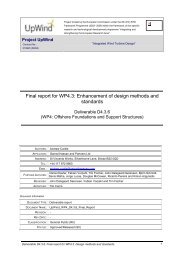Impact of Drivetrain on Wind Farm VAR Control - Upwind
Impact of Drivetrain on Wind Farm VAR Control - Upwind
Impact of Drivetrain on Wind Farm VAR Control - Upwind
You also want an ePaper? Increase the reach of your titles
YUMPU automatically turns print PDFs into web optimized ePapers that Google loves.
UPWIND<br />
4.2.5 Test Cases and Results<br />
The same test cases performed with the static-type excitati<strong>on</strong> were investigated with the<br />
brushless-type exciter. The results are summarized in Table 4-12.<br />
The same general c<strong>on</strong>clusi<strong>on</strong>s drawn before with <strong>on</strong>ly voltage c<strong>on</strong>trol can be applied with the<br />
reactive power c<strong>on</strong>trol implementati<strong>on</strong> where:<br />
• The POI voltage resp<strong>on</strong>se with the reactive power c<strong>on</strong>trol implementati<strong>on</strong> is slightly<br />
slower than that obtained with <strong>on</strong>ly the voltage c<strong>on</strong>trol.<br />
• The WTG reactive power limits were defined by the generator capability. However this<br />
prevented the POI voltage in some cases, with system SCR 20, from achieving the<br />
desired steady state value. This happened in cases 4 and 7 due to reaching the minimum<br />
WTG reactive power limit.<br />
• As observed before, applying the c<strong>on</strong>trol settings <str<strong>on</strong>g>of</str<strong>on</strong>g> higher system SCR to a lower <strong>on</strong>e<br />
would result in a faster resp<strong>on</strong>se (cases 10 and 11) and vice versa (case 12).<br />
• With higher initial WTG voltage (case 13), more reactive power margin was required to<br />
regulate the POI voltage.<br />
Deliverable D5.9.1 63











